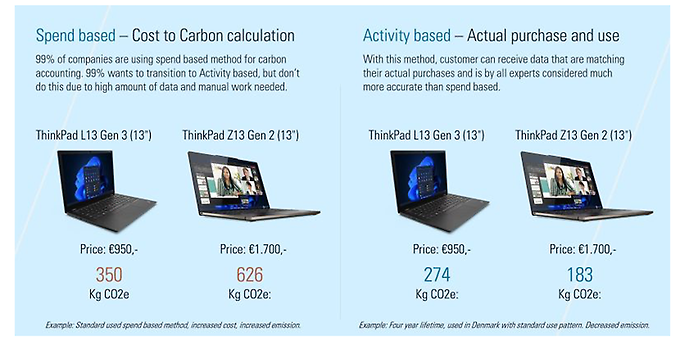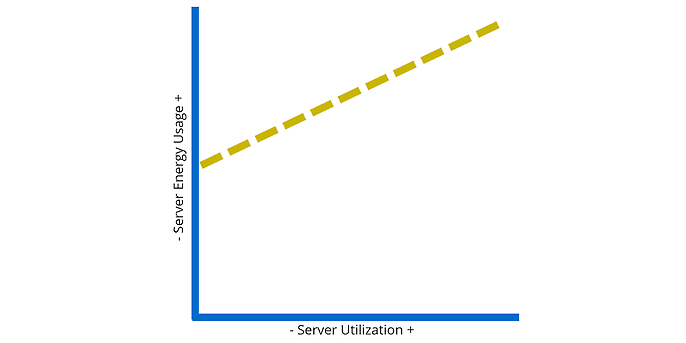18. March 2024 By Yelle Lieder
Green IT - building blocks of ecologically sustainable corporate IT
CIOs and CTOs will have to deal intensively with issues of environmental sustainability in the coming years. According to a survey conducted by Intel in 2023, 81 per cent of over 2,000 respondents see "green IT" at the top of their agenda. Gartner has also identified "sustainable technology" as one of the top three strategic technology trends for 2024. IT departments must contribute to corporate goals and therefore increasingly also to sustainability goals, be it through systems for managing sustainability data or reducing their footprint. To avoid falling into blind actionism, managers must therefore develop a green IT strategy that is aligned with existing corporate and IT strategies and derive measures. In this blog post, I will show you which building blocks such a strategy can contain.
Is green IT relevant for all companies?
Every company must ask itself whether its IT causes a relevant proportion of its emissions. Figure 1 shows that companies in the financial sector in particular have a proportionately high IT footprint. For companies whose footprint is largely caused by IT, increasing the sustainability of their IT is particularly effective in achieving sustainability goals.

Illustration 1 - Global Scope 2 emissions from enterprise IT by sector, source: https://www.mckinsey.com/capabilities/mckinsey-digital/our-insights/the-green-it-revolution-a-blueprint-for-cios-to-combat-climate-change
However, companies in other sectors must not ignore the sustainability of their IT either. If you want to become more sustainable overall, you cannot accept that individual areas of the company do not contribute to achieving the target. A holistic sustainability strategy simply includes sustainable IT, even if its share of total emissions is rather small. This is why, in addition to many companies from the financial sector, we are also seeing more and more companies endeavouring to achieve green IT - for example, tourism companies or household appliance manufacturers - where there may at first glance appear to be far more relevant sustainability challenges. If you want to become holistically sustainable and more digital in the future, there is no way around IT.
Evaluating the sustainability of IT
The first step towards sustainable IT is to understand the status quo. Headless actionism does not help to achieve sustainability goals. Only data-based action planning enables the acceptance and cost-effectiveness of a green IT strategy. A baseline must therefore be created from which optimisations can then be planned, implemented and evaluated retrospectively.
Inadequate methods for assessing the environmental impact of IT on the customer side and non-transparent or misleading information from providers are currently probably the biggest challenges for companies in the area of green IT. Compared to traditional "spend-based carbon accounting", LCA methods not only deliver much more realistic results but are also much more meaningful for decision-making due to their higher granularity. Figure 2 clearly shows why this frequently used and legally permissible extrapolation of costs to environmental impacts - i.e. spend-based carbon accounting - is usually not expedient. More costs are not always associated with more emissions.

Illustration 2 - Comparison of classic spend-based carbon accounting with the more effective activity-based carbon accounting
IT inventory lists, telemetry data from data centres, data from IT controlling as well as observability, logging and tracking data from applications can be used as a basis for assessing the current IT footprint. This data can be used to roughly derive the IT hardware in use, its potential power consumption and data on load distribution over time and the energy mix used. Following one-off reporting, it also makes sense to automatically merge the data sources obtained into a consistent data model and thus create a starting point for setting up continuous monitoring. Further insights into measuring the sustainability of software can be found in my blog post on the topic of "Testing the sustainability of software".
Sustainable IT provider management
Once the internally available IT sustainability data has been tapped, the next step should be via the providers. As experience has shown that the provision of data of reliable quality by providers is a lengthy process, initial discussions on this should be initiated as early as possible. The successful collection of an internal baseline can be used as an initial success to motivate other players to join in. As a significant proportion of IT emissions are not generated within the company itself, but by external providers - i.e. in Scope 3 according to GHG - measures are often particularly effective here due to economies of scale that are transferred to several of the provider's customers. Here, it is important to involve all providers - whether hardware leasing, SaaS, cloud or managed services - at an early stage and gradually increase the requirements. As soon as data is available, clear award criteria should be defined depending on the baseline. Overambitious demands for more sustainability will not help anyone if providers subsequently stop bidding for contracts. Instead, ambitious but achievable roadmaps should be jointly defined for the incremental optimisation of procured products and services. Many suppliers are willing to contribute to achieving their customers' sustainability goals, but they too must first establish the right processes to ensure high data quality and a lower environmental impact.
Sustainable software development as part of green IT
The classic term Green IT sounds outdated to some and is often associated with data centres and PC workstations. However, a holistic green IT strategy should not only consider the physical infrastructure, as the operation of hardware always also serves to provide software solutions. Experience shows that the optimisation of data centres - due to the ecological production costs of IT equipment and the underutilisation of many data centres - often offers greater overall ecological potential than the optimisation of software systems. The decommissioning of equipment and the avoidance of new purchases offer considerable ecological added value. Nevertheless, in most cases, it makes sense to optimise operating environments - whether in data centres or client hardware - only after the software running on them has already been optimised. Otherwise, you end up in an optimisation cycle in which the hardware is repeatedly adapted to the new, leaner hardware. Sustainable IT therefore does not work without a sustainable software landscape. Starting points for increasing sustainability at the software level can be found in my blog post on the topic of "Sustainable software architecture".
Green Office IT Equipment
When selecting suppliers, certifications and eco-labels should be taken into account as award criteria. Hardware should be certified according to environmental standards such as Blue Angel or Energy Star. Manufacturers should provide data on the environmental impact to enable a life cycle assessment. Information on the repairability score is becoming increasingly important for a circular economy. The definition of fixed equipment concepts facilitates green IT reporting by defining a fixed set of IT equipment and peripherals according to roles and requirement profiles within the company. This reduces the heterogeneity of the IT landscape and increases the compatibility of the hardware. Sustainability figures can be collected based on the equipment blocks, which makes inventorying easier. Concepts such as shared desk policies or thin clients can reduce the overall hardware requirements. At the end of the life cycle of IT hardware, consideration should be given to where it should remain. Refurbishment providers often offer full-service solutions in which the hardware is either sold on the secondary market in compliance with data protection regulations or recycled.
Sustainable data centres
In absolute terms, improvement measures in the data centre probably have one of the highest efficiencies of all green IT measures. However, as described in the section on software engineering, the data centre should not be the starting point, but rather the dimensioning of the data centres - i.e. after optimising the software - should be adapted to the new reality. This redimensioning or downsizing often results in hardware that is no longer required being switched off and sold. This is because the utilisation of the devices is decisive for their energy consumption. Underutilised devices consume a disproportionate amount of energy even when idle, which is why it makes sense to concentrate the workloads of several devices on fewer devices and thus benefit from a better ratio between work performance and energy consumption. The relationship between utilisation and energy consumption of a generic server is shown in Figure 3.

Illustration 3 - Relationship between utilisation and energy consumption of a generic server
Other measures to make data centres more sustainable include cold/hot aisle principles, where the waste heat is separated from the cooling supply, the purchase of more energy-efficient hardware or raising the general operating temperature. It is often sufficient to reduce the speed of the cooling fans to save electricity without any loss of performance.
Merging the individual parts into a green IT strategy
In this blog post, we have only looked at a small part of the possible solution modules for sustainable IT. Knowledge of the building blocks is a basic prerequisite for recognising the options for action within a green IT strategy and implementing them as required. However, the strategic dimension is still missing for the operationalisation of the activities.
- Under what conditions are the measures implemented?
- Are there interactions with other corporate objectives?
- What is the target maturity level?
- What added value can be expected beyond the ecological aspects?
- And what does a structured approach look like that also fits in with the organisational culture?
Simply working through the points presented is therefore not very promising. What is needed is a strategic framework that defines the right combination and characteristics of the building blocks presented, based on the organisation's objectives.
Ready for sustainable success? Start now with adesso! From strategy to implementation - together we make it happen. Contact us today for a more sustainable future!
You can find more exciting topics from the world of adesso in our previous blog posts.
Also interesting:

